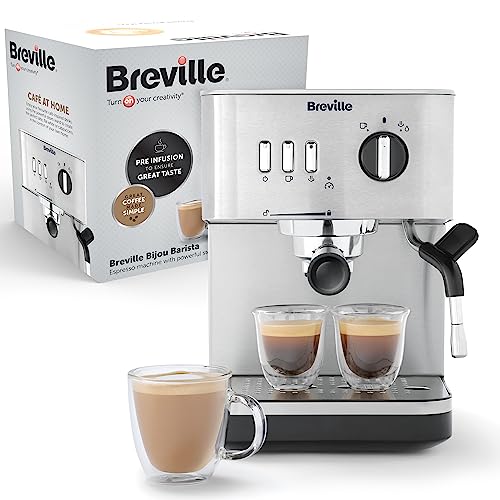Why People Don't Care About Commercial Espresso Machine
What to Look For in a Commercial Espresso Machine When buying a commercial coffee machine, there are a variety of factors to take into account. The kind of espresso machine suitable for your cafe will depend on the amount of use, the purpose, and barista's skills. A double boiler system gives the ability to brew as well as steam simultaneously. It also speeds up the recovery time between pulls. Proportional-integral-derivative (PID) temperature control manages on/off cycles for optimal boiler temperatures. Productivity A commercial espresso machine can handle a greater volume of coffee than a home machine. A home espresso machine will not be effective in a professional setting. A high quality commercial machine can serve up to 100 cups of coffee per hour during peak times. This can be a lifesaver for busy workplaces, stopping employees from having to stand around while waiting to get their coffee. A coffee maker can aid in bonding between workers. Teams of workers often are able to take turns ordering coffee for each other, which can encourage collaboration and teamwork in the workplace. Having a dedicated space for coffee can assist new employees to feel at comfortable in the workplace, breaking down any barriers between them and the senior employees. Commercial espresso machines are available in various sizes to meet a variety of needs. Some models are fully automated, while others can pre-program espresso shot sizes so that the operators don't have to guess the correct size. This is especially crucial for companies with baristas who are not trained as the wrong shots can alter the intensity and taste of brewed espresso. www.coffeee.uk is also recommended to purchase commercial espresso machines made of ethically sourced materials that benefit the communities where coffee beans are harvested. This will ensure that the product is of high quality and will minimize the negative impact on the environment. Safety Espresso machines are large heavy pieces of equipment that can cost the same as a brand new compact car. They're also built to pump out a multitude of drinks and shots throughout the course of one day. These high volume operations can create unique safety and health risks for staff members, so it's important to take into account the potential dangers that come with an espresso machine in a commercial setting. Remember that commercial espresso machines are likely to use warm water. This can encourage the growth of bacteria. A poorly maintained machine that isn't regularly cleaned or descaled may start to accumulate spent espresso, which can become rancid and cause illnesses if consumed by consumers. A commercial espresso machine with steam wands that are not sealed can allow bacteria to flourish in the milk foaming process. When you are choosing the best commercial espresso machine, it's important to consider the kind of drinks you'll be serving as well as how many cups your space can handle. It is important to select a machine with automation features that will make it simpler to serve your customers the best coffee drink. In addition, look for a warranty that covers parts and labor so that any technical issues can be addressed quickly and effectively. Energy Efficiency Commercial espresso machines require significantly more power than home models. Professional espresso machines weigh more and have larger capacity boilers that can support multiple group heads for standard cafe production. These machines also operate at a higher temperature in the ambient and are usually located in indoor locations (such as the cafe or restaurant) where the electronics can overheat rapidly, leading to the machine failing. The boiler of commercial espresso machines is heated and holds the pressurized water, which is supplied by an electric pump. The water is then used for brewing and steaming espresso. The boiler is made up of several copper tubes heated by electric elements. When the brew level sensor determines that the water has reached its desired level the solenoid valve is opened to fill the boiler with fresh water. The heating element is shut off. There are four types of espresso machines, differentiated by how they are able to brew and steam in the form of The TB (brewing only), TX (twin boilers) HX, DA (double automatic). TB and TX machines ensure stable brewing temperatures, whereas DA can provide rapid steaming using one boiler. Many cafes are converting to HX machines, since they have been proven to provide the best of both worlds, in terms of brew and steam temperatures. Maintenance Similar to how cars require routine tune-ups, commercial espresso machines require maintenance to continue working smoothly and efficiently. If you take care of your machine it will provide you with a better-tasting coffee and it will last longer. Cleaning your espresso machine is a routine practice, but it's crucial to clean your machine on a greater scale. There's bound to be leftovers of coffee grounds and milk products in the machine, which can cause the breakdown of various components over time. Regular cleaning will keep your espresso machine in top condition. Most commercial espresso machines require descaling every three months. This process requires a few extra steps as opposed to normal cleaning. It is recommended to review your manual so that you adhere to all the guidelines. Descaling requires a solution that dissolves the scale in the water tank. To do this you'll need to place a container underneath the steam wand and, in some models, underneath the coffee spouts. Then, follow the instructions for the model you have chosen.  Another important maintenance step is to change the water filters. It's easy to overlook but it's vital not to accumulate mineral deposits. Also, you should look for calcification in the spray head, which is difficult to get rid of.
Another important maintenance step is to change the water filters. It's easy to overlook but it's vital not to accumulate mineral deposits. Also, you should look for calcification in the spray head, which is difficult to get rid of.